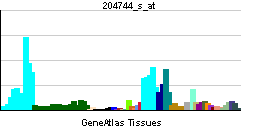IARS
| Isoleucyl-tRNA synthetase | |||||||||||
|---|---|---|---|---|---|---|---|---|---|---|---|
| Identifiers | |||||||||||
| Symbols | IARS ; FLJ20736; IARS1; ILRS; PRO0785 | ||||||||||
| External IDs | Template:OMIM5 Template:MGI HomoloGene: 5325 | ||||||||||
| |||||||||||
| RNA expression pattern | |||||||||||
 | |||||||||||
| More reference expression data | |||||||||||
| Orthologs | |||||||||||
| Template:GNF Ortholog box | |||||||||||
| Species | Human | Mouse | |||||||||
| Entrez | n/a | n/a | |||||||||
| Ensembl | n/a | n/a | |||||||||
| UniProt | n/a | n/a | |||||||||
| RefSeq (mRNA) | n/a | n/a | |||||||||
| RefSeq (protein) | n/a | n/a | |||||||||
| Location (UCSC) | n/a | n/a | |||||||||
| PubMed search | n/a | n/a | |||||||||
Isoleucyl-tRNA synthetase, also known as IARS, is a human gene.[1]
Aminoacyl-tRNA synthetases catalyze the aminoacylation of tRNA by their cognate amino acid. Because of their central role in linking amino acids with nucleotide triplets contained in tRNAS, aminoacyl-tRNA synthetases are thought to be among the first proteins that appeared in evolution. Isoleucine-tRNA synthetase belongs to the class-I aminoacyl-tRNA synthetase family and has been identified as a target of autoantibodies in the autoimmune disease polymyositis/dermatomyositis. Two alternatively spliced variants have been isolated that represent alternate 5' UTRs.[1]
References
Further reading
- Norcum MT (1991). "Structural analysis of the high molecular mass aminoacyl-tRNA synthetase complex. Effects of neutral salts and detergents". J. Biol. Chem. 266 (23): 15398–405. PMID 1651330.
- Nichols RC, Raben N, Boerkoel CF, Plotz PH (1995). "Human isoleucyl-tRNA synthetase: sequence of the cDNA, alternative mRNA splicing, and the characteristics of an unusually long C-terminal extension". Gene. 155 (2): 299–304. PMID 7721108.
- Shiba K, Suzuki N, Shigesada K; et al. (1994). "Human cytoplasmic isoleucyl-tRNA synthetase: selective divergence of the anticodon-binding domain and acquisition of a new structural unit". Proc. Natl. Acad. Sci. U.S.A. 91 (16): 7435–9. PMID 8052601.
- Nichols RC, Blinder J, Pai SI; et al. (1997). "Assignment of two human autoantigen genes-isoleucyl-tRNA synthetase locates to 9q21 and lysyl-tRNA synthetase locates to 16q23-q24". Genomics. 36 (1): 210–3. doi:10.1006/geno.1996.0449. PMID 8812440.
- Rho SB, Lee KH, Kim JW; et al. (1996). "Interaction between human tRNA synthetases involves repeated sequence elements". Proc. Natl. Acad. Sci. U.S.A. 93 (19): 10128–33. PMID 8816763.
- Degoul F, Brulé H, Cepanec C; et al. (1998). "Isoleucylation properties of native human mitochondrial tRNAIle and tRNAIle transcripts. Implications for cardiomyopathy-related point mutations (4269, 4317) in the tRNAIle gene". Hum. Mol. Genet. 7 (3): 347–54. PMID 9466989.
- Rho SB, Lee JS, Jeong EJ; et al. (1998). "A multifunctional repeated motif is present in human bifunctional tRNA synthetase". J. Biol. Chem. 273 (18): 11267–73. PMID 9556618.
- Quevillon S, Robinson JC, Berthonneau E; et al. (1999). "Macromolecular assemblage of aminoacyl-tRNA synthetases: identification of protein-protein interactions and characterization of a core protein". J. Mol. Biol. 285 (1): 183–95. doi:10.1006/jmbi.1998.2316. PMID 9878398.
- Strausberg RL, Feingold EA, Grouse LH; et al. (2003). "Generation and initial analysis of more than 15,000 full-length human and mouse cDNA sequences". Proc. Natl. Acad. Sci. U.S.A. 99 (26): 16899–903. doi:10.1073/pnas.242603899. PMID 12477932.
- Bouwmeester T, Bauch A, Ruffner H; et al. (2004). "A physical and functional map of the human TNF-alpha/NF-kappa B signal transduction pathway". Nat. Cell Biol. 6 (2): 97–105. doi:10.1038/ncb1086. PMID 14743216.
- Humphray SJ, Oliver K, Hunt AR; et al. (2004). "DNA sequence and analysis of human chromosome 9". Nature. 429 (6990): 369–74. doi:10.1038/nature02465. PMID 15164053.
- Kimura K, Wakamatsu A, Suzuki Y; et al. (2006). "Diversification of transcriptional modulation: large-scale identification and characterization of putative alternative promoters of human genes". Genome Res. 16 (1): 55–65. doi:10.1101/gr.4039406. PMID 16344560.
- Ewing RM, Chu P, Elisma F; et al. (2007). "Large-scale mapping of human protein-protein interactions by mass spectrometry". Mol. Syst. Biol. 3: 89. doi:10.1038/msb4100134. PMID 17353931.
| This protein-related article is a stub. You can help Wikipedia by expanding it. |